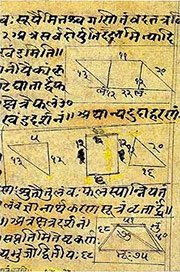Bhajita, Bhājita: 9 definitions
Introduction:
Bhajita means something in Hinduism, Sanskrit, Buddhism, Pali, Marathi. If you want to know the exact meaning, history, etymology or English translation of this term then check out the descriptions on this page. Add your comment or reference to a book if you want to contribute to this summary article.
In Hinduism
Ganitashastra (Mathematics and Algebra)
Source: archive.org: Hindu MathematicsBhājita (भाजित) refers to “divided” whereas its abbreviation (bhā) refers to the “operation of division”, according to the principles of Bījagaṇita (“algebra” or ‘science of calculation’), according to Gaṇita-śāstra, ancient Indian mathematics and astronomy.—There are no special symbols for the fundamental operations in the Bakhshali work. Any particular operation intended is ordinarily indicated by placing the tachygraphic abbreviation, the initial syllable of a Sanskrit word of that import, after, occasionally before, the quantity affected. Thus the operation of addition is indicated by yu (an abbreviation from yuta, meaning added), subtraction by + which is very probably from kṣa (abbreviated from kṣaya, diminished), multiplication by gu (from gum or guṇita, multiplied) and division by bhā (from bhāga or bhājita, divided).

Ganitashastra (शिल्पशास्त्र, gaṇitaśāstra) refers to the ancient Indian science of mathematics, algebra, number theory, arithmetic, etc. Closely allied with astronomy, both were commonly taught and studied in universities, even since the 1st millennium BCE. Ganita-shastra also includes ritualistic math-books such as the Shulba-sutras.
Languages of India and abroad
Pali-English dictionary
Source: BuddhaSasana: Concise Pali-English Dictionarybhajita : (pp. of bhajati) associated with; kept company. || bhājita (pp. of bhājeti) divided; distributed.
Source: Sutta: The Pali Text Society's Pali-English DictionaryBhājita, (pp. of bhājeti) divided, distributed; nt. that which has been dealt out or allotted, in cpd. bhājit-âbhājita A. III, 275. (Page 501)

Pali is the language of the Tipiṭaka, which is the sacred canon of Theravāda Buddhism and contains much of the Buddha’s speech. Closeley related to Sanskrit, both languages are used interchangeably between religions.
Marathi-English dictionary
Source: DDSA: The Molesworth Marathi and English Dictionarybhājita (भाजित).—p S In arithmetic. Divided. 2 Divided, distributed, portioned.
Marathi is an Indo-European language having over 70 million native speakers people in (predominantly) Maharashtra India. Marathi, like many other Indo-Aryan languages, evolved from early forms of Prakrit, which itself is a subset of Sanskrit, one of the most ancient languages of the world.
Sanskrit dictionary
Source: DDSA: The practical Sanskrit-English dictionaryBhājita (भाजित).—a. Shared, divided.
-tam A share, portion.
Source: Cologne Digital Sanskrit Dictionaries: Shabda-Sagara Sanskrit-English DictionaryBhājita (भाजित).—mfn.
(-taḥ-tā-taṃ) Divided, portioned. n.
(-taṃ) A portion, a share. E. bhāj to divide, aff. kta .
Source: Cologne Digital Sanskrit Dictionaries: Monier-Williams Sanskrit-English Dictionary1) Bhājita (भाजित):—[from bhāga] mfn. ([from] [Causal]) shared, divided, [Sūryasiddhānta]
2) [v.s. ...] distributed, portioned, [Horace H. Wilson]
3) [v.s. ...] n. a share, portion, [ib.]
Source: Cologne Digital Sanskrit Dictionaries: Yates Sanskrit-English DictionaryBhājita (भाजित):—[(taḥ-tā-taṃ) a.] Divided. n. Share.
Source: DDSA: Paia-sadda-mahannavo; a comprehensive Prakrit Hindi dictionary (S)Bhājita (भाजित) in the Sanskrit language is related to the Prakrit word: Bhāia.
Sanskrit, also spelled संस्कृतम् (saṃskṛtam), is an ancient language of India commonly seen as the grandmother of the Indo-European language family (even English!). Closely allied with Prakrit and Pali, Sanskrit is more exhaustive in both grammar and terms and has the most extensive collection of literature in the world, greatly surpassing its sister-languages Greek and Latin.
See also (Relevant definitions)
Starts with: Bhajitabba, Bhajitavya.
Ends with: Anubhajita, Anyonyabhajita, Avibhajita, Paribhajita, Sabhajita, Samvibhajita, Susabhajita, Vibhajita, Viprabhajita.
Full-text: Anyonyabhajita, Vibhajita, Vikriya, Bhajeti, Pacitam, Bhaia, Yuta, Gunita, Gu, Yu, Ksha, Bha, Kshaya, Bhaga, Bhaj.
Relevant text
Search found 1 books and stories containing Bhajita, Bhājita; (plurals include: Bhajitas, Bhājitas). You can also click to the full overview containing English textual excerpts. Below are direct links for the most relevant articles:
Kashyapa Shilpa-shastra (study) (by K. Vidyuta)
2. Types of Maṇḍapas < [Chapter 4 - Maṇḍapa Lakṣaṇa]